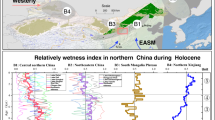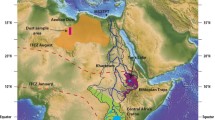Abstract
We present the first quantitative estimation of monsoon precipitation during the late glacial-Holocene in the sandy land of northern China, based on organic carbon isotopic composition data from a loess-sand sequence at margin of the Mu Us sandy land. We use the relationship between monsoon precipitation and the carbon isotopic composition of modern soils as an analogue, with a minor modification, to reconstruct precipitation back to c. 47 ka ago. The preliminary results indicate that annual monsoon precipitation was high after 8 ka, with an average of 435 mm; and it decreased during 18 and 8 ka with a mean value of 194 mm. The precipitation value of 47-18 ka varied between the two. We compare the reconstructed precipitation with other records and paleoclimatic modeling results, showing that our record agrees with reconstructions of the monsoon precipitation from other sources, even capturing short climatic events such as the Younger Dryas. We suggest that solar irradiance, high-latitude temperature/ice volume and local evaporation have together modified moistures in the sandy land.
Similar content being viewed by others
References
An Z S, Huang Y S, Liu W G et al., 2005. Multiple expansions of C4 plant biomass in East Asia since 7 Ma coupled with strengthened monsoon circulation. Geology, 33: 705–708.
Berger A, Loutre M F, 1991. Insolation values for the climate of the last 10 million years. Quaternary Science Reviews, 10: 297–317.
Bloemendal J, Liu X M, 2005. Rock magnetism and geochemistry of two plio-pleistocene Chinese loess-palaeosol sequences: Implications for quantitative palaeoprecipitation reconstruction. Palaeogeography, Palaeoclimatology, Palaeoecology, 226: 149–166.
Cerling T E, Harris J M, MacFadden B J et al., 1997. Global vegetation change through the Miocene/Pliocene boundary. Nature, 389: 153–158.
Cerling T E, Quade J, Wang Y et al., 1989. Carbon isotopes in soil and paleosols as ecologic and paleoecologic indicators. Nature, 341: 138–139.
Chen F H, Rao Z G, Zhang J W et al., 2006. Variations of organic carbon isotopic composition and its environmental significance during the last glacial on western Chinese Loess Plateau. Chinese Science Bulletin, 51: 1593–1602.
Gu Z Y, Liu Q, Xu B et al., 2003. Climate as the dominant control on C3 and C4 plant abundance in the Loess Plateau: Organic carbon isotope evidence from the last glacial-interglacial loess-soil sequences. Chinese Science Bulletin, 48: 1271–1276.
Guiot J, Torre F, Jolly D et al., 2000. Inverse vegetation modeling by Monte Carlo sampling to reconstruct palaeoclimates under changed precipitation seasonality and CO2 conditions: Application to glacial climate in Mediterranean region. Ecological Modelling, 127: 119–140.
Hatté C, Antoine P, Fontugne M et al., 2001. δ13C of loess organic matter as a potential proxy for paleoprecipitation. Quaternary Research, 55: 33–38.
Hatté C, Fontugne M, Rousseau D D et al., 1998. δ13C variations of loess organic matter as a record of the vegetation response to climatic changes during the Weichselian. Geology, 26: 583–586.
Heller F, Shen C D, Beer J et al., 1993. Quantitative estimates of pedogenic ferromagnetic mineral formation in Chinese loess and palaeoclimatic implications. Earth and Planetary Science Letters, 114: 385–390.
Huang Y, Street-Perrott F A, Metcalfe S E et al., 2001. Climate change as the dominant control on glacial-interglacial variations in C3 and C4 plant abundance. Science, 293: 1647–1651.
Jiang D B, Lang X M, 2010. Last Glacial Maximum East Asian monsoon: Results of PMIP simulations. Journal of Climate, 23: 5030–5038.
Jiang D B, Lang X M, Tian Z P et al., 2011. Last glacial maximum climate over China from PMIP simulations. Palaeogeography, Palaeoclimatology, Palaeoecology, 309: 347–357.
Jiang D, Lang X M, Tian Z P et al., 2013. Mid-Holocene East Asian summer monsoon strengthening: Insights from Paleoclimate Modeling Intercomparison Project (PMIP) simulations. Palaeogeography, Palaeoclimatology, Palaeoecology, 369: 422–429.
Lin B H, Liu R M, An Z S, 1991. Preliminary research on stable isotopic compositions of Chinese loess. In: Liu T S (eds). Loess, Environment and Global Change. Beijing: Science Press, 124–131. (in Chinese)
Liu W G, Feng X H, Ning Y F et al., 2005. δ13C variation of C3 and C4 plants across an Asian monsoon rainfall gradient in arid northwestern China. Global Change Biology, 11: 1094–1100.
Liu W G, Huang Y S, An Z S et al., 2005. Summer monsoon intensity controls C4/C3 plant abundance during the last 35 ka in the Chinese Loess Plateau: Carbon isotope evidence from bulk organic matter and individual leaf waxes. Palaeogeography, Palaeoclimatology, Palaeoecology, 220: 243–254.
Liu W G, Ning Y F, An Z S et al., 2005. Carbon isotopic composition of modern soil and paleosol as a response to vegetation change on the Chinese Loess Plateau. Science in China Series D: Earth Sciences 48: 93–99.
Liu X M, Rolph T, Bloemendal J et al., 1995. Quantitative estimates of palaeoprecipitation at Xifeng, in the Loess Plateau of China. Palaeogeography, Palaeoclimatology, Palaeoecology, 113: 243–248.
Lu H Y, Miao X D, Zhou Y L et al., 2005. Late Quaternary aeolian activity in the Mu Us and Otindag dune fields (North China) and lagged response to insolation forcing. Geophysical Research Letters, 32(21), L21716, doi: 10.1029/2005GL024560.
Lu H Y, Wu N Q, Liu T S et al., 1996. Seasonal climatic variation recorded by phytolith assemblages from the Baoji loess sequence in central China over the last 150 000 a. Science in China Series D, Earth Science, 39: 629–639. (in Chinese)
Lu H Y, Yi S W, Liu Z Y et al., 2013. Variation of East Asian monsoon precipitation during the past 21 k.y. and potential CO2 forcing. Geology, 41(9): 1023–1026.
Lu H Y, Zhou Y L, Liu W G et al., 2012. Organic stable carbon isotopic composition reveals late Quaternary vegetation changes in the dune fields of northern China. Quaternary Research, 77: 433–444.
Maher B A, Thompson R, Zhou L P, 1994. Spatial and temporal reconstructions of changes in the Asian palaeomonsoon: A new mineral magnetic approach. Earth and Planetary Science Letters, 125: 461–471.
Mason J A, Lu H Y, Zhou Y L et al., 2009. Dune mobility and aridity at the desert margin of northern China at a time of peak monsoon strength. Geology, 37: 947–950.
Mingram J, Schettler G, Nowaczyk N et al., 2004. The Huguang Maar Lake: A high-resolution record of palaeoenvironmental and palaeoclimatic changes over the last 78,000 years from South China. Quaternary International, 122: 85–107.
Mosbrugger V, Utescher T, 1997. The coexistence approach: A method for quantitative reconstructions of Tertiary terrestrial palaeoclimate data using plant fossils. Palaeogeography, Palaeoclimatology, Palaeoecology, 134: 61–86.
Murray A S, Wintle A G, 2000. Luminescence dating of quartz using an improved single-aliquot regenerative-dose protocol. Radiation Measurements, 32: 57–73.
Ning Y F, Liu W G, An Z S, 2008. A 130-ka reconstruction of precipitation on the Chinese Loess Plateau from organic carbon isotopes. Palaeogeography, Palaeoclimatology, Palaeoecology, 270: 59–63.
Quade J, Cerling T E, Bowman J R, 1989. Development of Asian monsoon revealed by marked ecological shift during the latest Miocene in northern Pakistan. Nature, 342: 163–165.
Rao Z G, Chen F H, Cheng H et al., 2013. High-resolution summer precipitation variations in the western Chinese Loess Plateau during the last glacial. Scientific Reports, 3: 2785, doi: 10.1038/srep02785.
Rao Z G, Zhu Z Y, Chen F H et al., 2006. Does δ13Ccarb of the Chinese loess indicate past C3/C4 abundance? A review of research on stable carbon isotopes of the Chinese loess. Quaternary Science Reviews, 25: 2251–2257.
Schulze E D, Ellis R, Schulze W et al., 1996. Diversity, metabolic types and δ13C carbon isotope ratios in the grass flora of Namibia in relation to growth form, precipitation and habitat conditions. Oecologia, 106: 352–369.
Stewart G, Turnbull M, Schmidt S et al., 1995. 13C natural abundance in plant communities along a rainfall gradient: A biological integrator of water availability. Australian Journal of Plant Physiology, 22: 51–55.
Sun J M, Diao G Y, Wen Q Z et al., 1999. A preliminary study on quantitative estimate of palaeoclimate by using geochemical transfer function in the Loess Plateau. Geochimica, 28: 265–272. (in Chinese)
Wang G A, Han J M, Liu T S, 2003. The carbon isotope composition of C3 herbaceous plants in loess area of northern China. Science in China Series D: Earth Sciences, 46: 1069–1076.
Wang L J, Sarnthein M, Erlenkeuser H et al., 1999. East Asian monsoon climate during the Late Pleistocene: High-resolution sediment records from the South China Sea. Marine Geology, 156: 245–284.
Wang Y J, Cheng H, Edwards R L et al., 2001. A high-resolution absolute-dated late Pleistocene monsoon record from Hulu Cave, China. Science, 294: 2345–2348.
Wang Y J, Cheng H, Edwards R L et al., 2008. Millennial- and orbital-scale changes in the East Asian monsoon over the past 224,000 years. Nature, 451: 1090–1093.
Wu N Q, Lu H Y, Sun X J et al., 1994. Climate transfer function from opal phytolith and its application in paleoclimate reconstrution of China loess-paleosol sequence. Quaternary Sciences, 270–279. (in Chinese)
Xia D S, Jia J, Wei H T et al., 2012. Magnetic properties of surface soils in the Chinese Loess Plateau and the adjacent Gobi areas, and their implication for climatic studies. Journal of Arid Environments, 78: 73–79.
Yao Z, Wu H, Liang M et al., 2011. Spatial and temporal variations in C3 and C4 plant abundance over the Chinese Loess Plateau since the last glacial maximum. Journal of Arid Environments, 75: 881–889.
Yu K F, Lu H Y, Frank L et al., 2013. A preliminary quantitative paleoclimate reconstruction of the dune fields of northern China during the last glacial maximum and Holocene optimum. Quaternary Sciences, 33: 293–302. (in Chinese)
Author information
Authors and Affiliations
Corresponding author
Additional information
Foundation: National Natural Science Foundation of China, No.41321062; No.41371203; The Global Changes Program of China, 2010CB950203; The Priority Academic Program Development of Jiangsu Higher Education Institutions, The Fundamental Research Funds for the Central Universities, No.1082020904
Author: Chen Yingyong, PhD, specialized in land surface process and environment change.
Rights and permissions
About this article
Cite this article
Chen, Y., Lu, H., Yi, S. et al. A preliminary quantitative reconstruction of precipitation in southern Mu Us sandy land at margin of Asian monsoon-dominated region during late Quaternary. J. Geogr. Sci. 25, 301–310 (2015). https://doi.org/10.1007/s11442-015-1169-8
Received:
Accepted:
Published:
Issue Date:
DOI: https://doi.org/10.1007/s11442-015-1169-8




